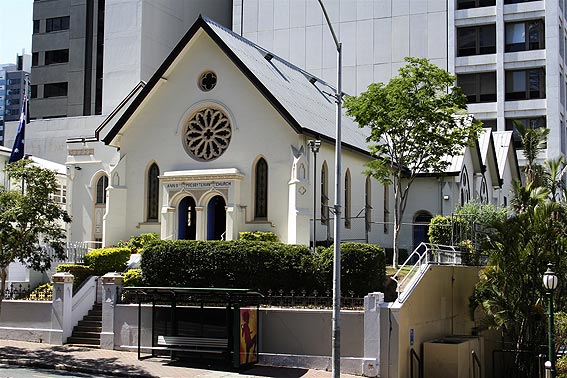
The Presbyterian Church, Ann Street
[Photograph by Trevor Bunning (October 2007)]

The Presbyterian Church, Ann Street
[Photograph by Trevor Bunning (October 2007)]
Historical and Technical Documentation by Geoffrey Cox
© OHTA 1989, 2007, 2011, 2014 (last updated July 2014)
The congregation of the Ann Street Presbyterian Church originated from a group established in 1849 by the Rev. Thomas Mowbray. At a meeting held at Kangaroo Point in that year, they resolved to 'form a Church in which the great doctrines of the Westminster Confession of Faith and other standards adhered to by the Evangelical Presbyterians of Great Britain and Ireland will be maintained.'1
They first built a small wooden church in 1851 in Grey Street, South Brisbane, but the congregation divided itself in 1857, some moving to the north side of the river and becoming known as the 'Ann Street congregation.' The Ann Street congregation opened a church on the present site in 1858. The interior of the building was burnt out in 1871 and it was rebuilt the following year.2 The building was reconstructed and enlarged in 1897 to the design of the Brisbane-based and Scottish-born architect, Alexander B. Wilson.3


[Photographs by Trevor Bunning (October 2007)]
The organ was built by Charles Richardson of Sydney in association with his father's firm, W.E. Richardson & Sons of Manchester. Proposals for an organ in the enlarged church date from at least May 1901, when there was correspondence between Mr T. Mirfin of Brisbane and George Fincham of Melbourne concerning a 'proposed organ for the Presbyterian Church, Brisbane.'4 By December 1901, however, a decision was said to have been made to purchase an organ that would cost £600 in London.5 The organ committee met under the chairmanship of Mr J. McCallum, the organist, who went to Sydney to assist with the shipping of the organ. Richardson visited Brisbane in July 1902 and quoted £650 to build and install the instrument. Mr George Sampson received payment in September 1902 as the consultant.6 McCallum was able to report to the congregation on 23 November that he considered the organ 'second to none in Australasia.'7

Mr J. N. McCallum
[Photograph: The Daily Mail (10 March 1906), p. 9]
A description of the organ published in The Daily Mail (10 March 1906) gives further details, including some of the official opening in November 1903:
ANN-STREET PRESBYTERIAN CHURCH ORGAN
The organist and choirmaster at the Ann-street Presbyterian Church is Mr John. N. McCallum. The organ is one with two manuals and pedals, and is fitted throughout with pneumatic action. There is a detached console, and it is blown by hydraulic power. To conform with the church architecture the case has been completed in kauri and cedar. On the great there are 58 notes, and 58 notes are on the swell organ, whilst the pedal organ has 30 notes. The couplers are great to pedal, swell to pedal, and swell to great, with six pneumatic thumb pistons, a pneumatic swell pedal, and tremulant to swell.
On the 18th November 1903, the official opening of the organ took place when Mr. George Sampson, F.R.C.O., provided music by such composers as Guilmant, Mendelssohn, and Wely. The instrument then proved its value, which has since been accentuated, the improvement having come with use. The builder is Mr. Charles Richardson, Sydney.8
This was amongst Charles Richardson's largest instruments, most of which were built for locations in New South Wales.9 The Ann Street organ used tubular-pneumatic action throughout. The console was detached, and placed originally in front of the pulpit. Even the connection between the swell pedal and the swell shutters was pneumatic. The organ was blown originally by a hydraulic engine working two pairs of vertical feeders placed in a room below the organ, and there was an auxiliary hand blowing apparatus. The windchests were slideless, employing a 'ventil system which provides a separate and distinct pallet for each pipe.' The original pedal board (which has not survived) was described as 'concave, and made to the latest scale of the Royal College of Organists.'10
A photograph that appeared first in The Brisbane Courier (16 November 1903) was reprinted in The Daily Mail (10 March 1906), showing the original position of the console in front of the pulpit:

The Charles Richardson organ of 1903
[Photograph: The Daily Mail (10 March 1906), p. 9]
Richardson worked in collaboration with his father's firm, W.E. Richardson & Sons of Manchester, and the design and manufacture of instruments was shared between the two. The metal pipes for the Ann Street organ were described as having been 'manufactured in London from the best spotted metal.' The casework shows obvious similarities to that of the 1899 W.E. Richardson & Sons organ at St Andrew's Presbyterian Church, Rockhampton, for which the casework was made by Charles Richardson in Sydney. The console at Ann Street is of English oak, but the case is of kauri pine and cedar, 'being constructed to carry out the decoration scheme initiated by the architect.' The front pipes were described at the time as 'most artistically decorated in French gray, terra cotta, chocolate, and gold.'11

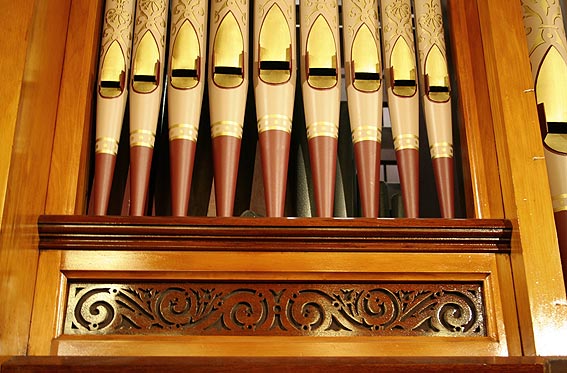
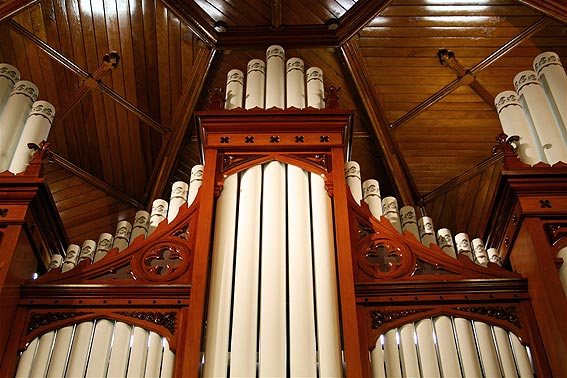
Casework details
[Photographs by Trevor Bunning (October 2007)]
The console was moved to its present position adjacent to the case in 1921, at which time the pneumatic action was reversed by Whitehouse Bros of Brisbane from the exhaust system to the supply (pressure) system at a total cost of £395.10.0.12 Additions were made around 1929-30, comprising a larger Open Diapason 8ft on the Great, which doubled as a Pedal Octave 8ft (described as 'Viocello' in the firm's ledger), along with a new pedalboard and new swell mechanism:13
To addition of new open Dia to Great organ, new Viocello |
||
also renovation & replacement of old parts as per letter dated 2/7/29. |
£290 |
|
addition of new R.C.O. pedal board & new pneumatic box |
£ 38 |
|
____ £328 |
There were routine minor repairs during the 1940s and early 1950s, and the organ was overhauled by Whitehouse Bros in 1955 at a cost of £872.5.5.14 No other significant changes were made until around 1981, when the instrument was partially dismantled by Whitehouse Bros in preparation for rebuilding and electrification. By the time the firm ceased operation in 1982, the pedalboard and the swell shutters had been removed, a balanced swell pedal had been installed, and the pipes of the Swell (and Pedal) Bourdon 16ft had disappeared.15 The instrument remained in this state for the next two decades.
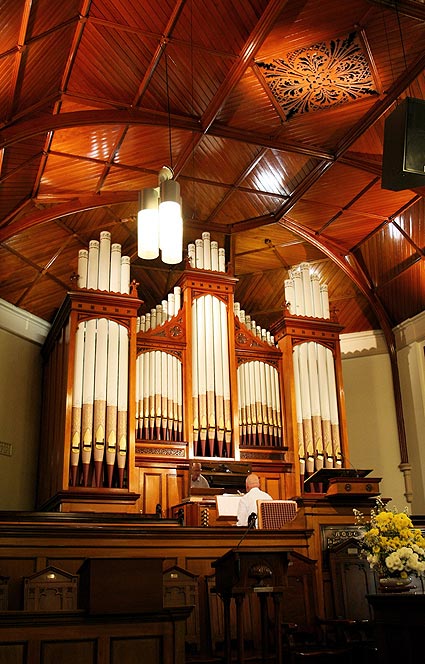
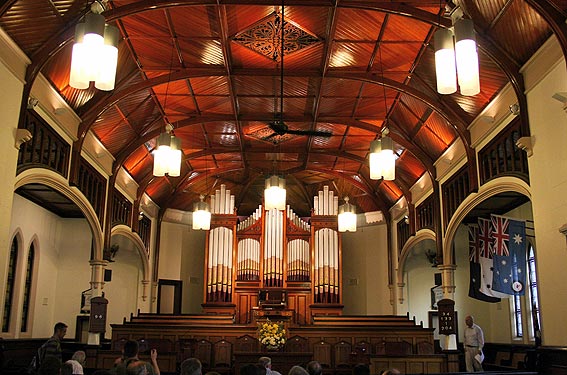
[Photographs by Trevor Bunning (October 2007)]
The organ was restored by W.J. Simon Pierce in 2004. This included the removal of the 1929-30 Great Open Diapason/Pedal Octave rank, for which there had never really been adequate space inside the organ, and the reconstruction of a trigger swell mechanism. Pierce also negotiated the return of the original Swell Bourdon, which had spent some years in exile in another organ at St Peter's Lutheran College, Indooroopilly. Some slides were required to stabilize the tuning of the Great pipework. Restoration of the console included recovering of the keys in ivory resin, replication of the original tropic pinning and re-engraving of the drawstop labels.16
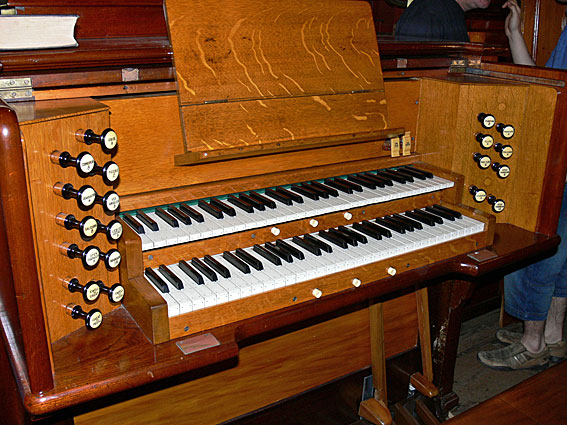
[Photograph by John Maidment (October 2007)]



Console details
[Photographs by Trevor Bunning (October 2007)]
| GREAT Open Diapason Hohl Flöte Dulciana Principal Flute Flautina SWELL Bourdon Open Diapason Lieblich Gedact Salicional Vox Angelica Gemshorn Piccolo Cornopean Oboe PEDAL Open Diapason Bourdon COUPLERS Great to Pedal Swell to Pedal Swell to Great Swell Sub Swell Super |
8 8 8 4 4 2 16 8 8 8 8 4 2 8 8 16 16 |
A A |
[metal] [wood] [metal] [metal] [metal] [metal] [wood] [metal] [wood] [metal] [Ten. C] [metal] [metal] [metal] [metal] [metal] [wood] [wood] [1921?] [1921?] |
Drawstop console; tropic-pinned ivories (originally detached)
3 thumb pistons to Great and Pedal Organs
3 thumb pistons to Swell Organ
Great to Pedal reversible rocking pedal (horseshoe type) [removed?]
Swell tremulant (hitch-down)
Pedalboard: radiating and concave (not original)
Compass: 58/30
Trigger swell lever
Pneumatic action.17

Single-rise bellows
[Photograph by Trevor Bunning (October 2007)]
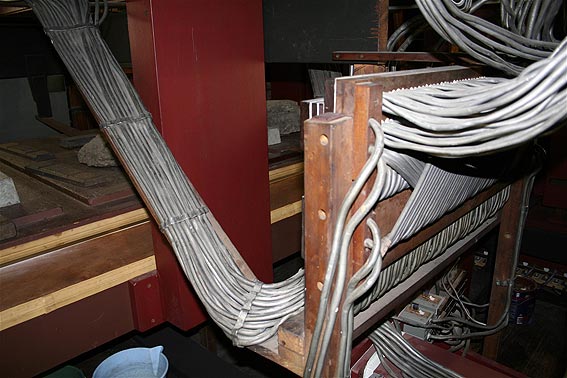

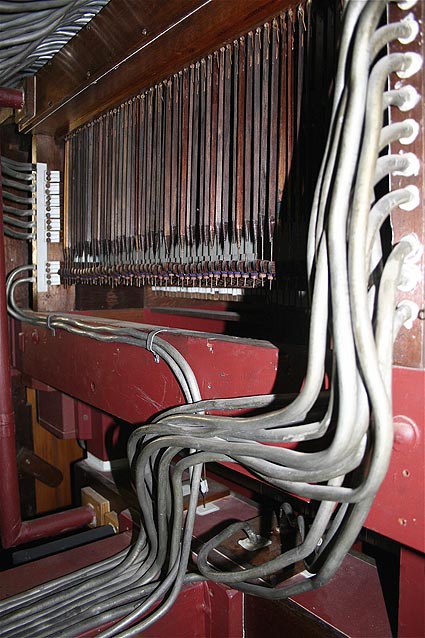

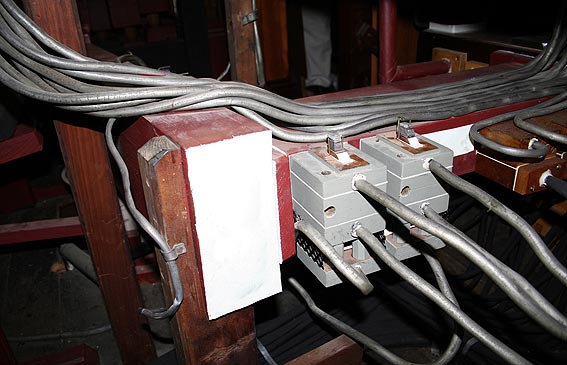
Action details
[Photographs by Trevor Bunning (October 2007)]
________________________________________________________________________
1 Richard Bardon, The Centenary History of The Presbyterian Church of Queensland (Brisbane: W.R. Smith & Paterson, 1949), p. 20.
2 Ibid, pp. 20-21, 217.
3 Queensland Heritage Council, Queensland Heritage Register, location 600071; Donald Watson & Judith McKay, Queensland Architects of the 19th Century: A Biographical Dictionary (Brisbane: Queensland Museum, 1994), pp. 208-10.
4 George Fincham Letter Book 18, p. 107 (16 May 1901). Subsequent correspondence in George Fincham Letter Book 18, p. 619 (25 May 1902) and in Letter Book 19, p. 632 (20 November 1903).
5 The Brisbane Courier (13 December 1901), p. 4.
6 Church records supplied to G. Cox by Rev. S. McCafferty, December 1973.
7 Church records supplied to G. Cox by Rev. S. McCafferty, December 1973.
8 The Daily Mail (10 March 1906), p. 9; see also The Brisbane Courier (17 November 1903), p. 5.
9 Graeme Rushworth, Historic Organs of New South Wales (Sydney: Hale & Iremonger, 1988), pp. 122-35.
10 The Brisbane Courier (16 November 1903), p. 7.
11 The Brisbane Courier, loc. cit; The Daily Mail , op. cit.
12 Whitehouse Bros List gives 'Rebuilt 1921 £395.10.0.'
13 Whitehouse Bros Ledger (1922-1940), p. 494. The final payment was made in March 1931.
14 Whitehouse Bros Ledger (1940-1954), pp. 337, 227; 1955 details from Whitehouse Bros List.
15 This rank had been re-deployed by Whitehouse Bros in the organ at St Peter's Lutheran College, Indooroopilly.
16 The Organ Voice, vol. 30, no. 3 (September 2003), p. 26; The Organ Voice, vol. 31, no. 1 (March 2004), back cover; The Organ Voice, vol. 31, no. 2 (June 2004), p. 23; The Organ Voice, vol. 31, no. 4 (December 2004), p. 14; OHTA News, vol. 29, no. 1 (January 2005), p. 11; OHTA News, vol. 29, no. 2 (April 2005), pp. 8-9.
17 Specification noted by G. Cox, 1973, 2004 and 2007. Additional details from The Brisbane Courier (16 November 1903), p. 7.